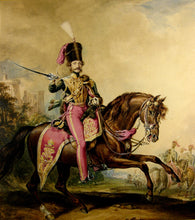Watercolour Portrait of James Thomas Brudenell, 7th Earl of Cardigan, K.C.B. (1797-1868), Circa 1850
Adding product to your cart
Overall: 58cm (23in) x 52cm (20.5in)
Watercolour on paper, circa 1850, after Sir Francis Grant's portrait of 1841 at Deene Park, Northamptonshire. Presented in an early 20th century gilt wood frame by Frederick Daniell, Cranbourn Street, London. Reglazed with conservation glass. Image size: 44cm (17.25in) x 39cm (15.5in).
Famous for leading the British Light Cavalry Brigade to destruction in a frontal assault on a battery of Russian artillery at the Battle of Balaclava in September 1854, Lord Cardigan epitomised the arrogant and extravagant aristocrat of his time. Reactionary, personally brave and surprisingly charitable, his progression through the Army was marked by episodes of controversy and irrational dislikes. As a member of the landed aristocracy he actively and steadfastly opposed any political reform, until relenting in the final year of his life.
Read more
After an inglorious career at Harrow School and Christ Church, Oxford, preparatory to a parliamentary career, he formed his own troop of horse to suppress reformist demonstrations. He joined the 8th Hussars in 1824, and making ready use of the purchase of commissions system rose rapidly to the command of the 11th Light Dragoons (restyled 11th Hussars in 1840) at a reported premium of £40,000 in 1836.
In pursuing his desire to command an elite regiment, Cardigan made many enemies, these included long-serving officers of limited personal means who resented the necessity of purchasing the expensive uniform introduced by Cardigan. ‘Indian officers’, meaning those that had served in the regiment during its long tour of India, were another dislike. His acquittal in 1841 following a duel with subordinate officer of many years service on a legal technicality was widely perceived as another example of out-dated aristocratic privilege.
Despite the reservations of many, Cardigan obtained the command of the Light Brigade in the Cavalry Division bound for the Crimean War in 1854. The division was commanded by his brother-in-law Lord Lucan, whom he thought did not treat his sister well. Following the communications mix up that unleashed the Brigade on 25 September 1854 into Tennyson’s ‘Valley of Death’, Cardigan expressed his misgivings but on receiving a direct order from Lucan in front of the troops, attacked as directed, remaining during the advance 'the very incarnation of bravery' as his aide-de-camp Sir George Wombwell put it. There is no doubt that Cardigan overran the Russian battery as he was recognized there by Prince Radziwill whom he had know before the war. However, aspersions were afterwards cast on the manner of Cardigan’s return resulting in attempts to mount an action for criminal libel in 1863. Cardigan later claimed that with duty done and disdaining to fight among the private soldiers he chose to return to the British lines (and the comfort of his private yacht beyond) with his charger Ronald at the walk, but other witnesses claimed to have seen him galloping to the rear and only slowing when he realized he was being watched.






